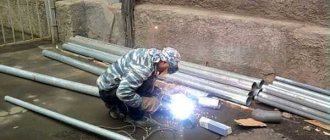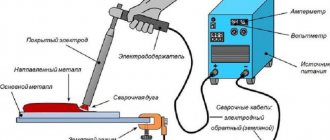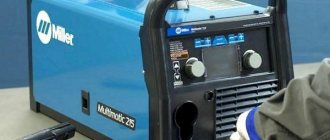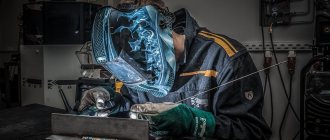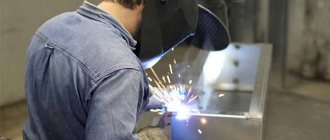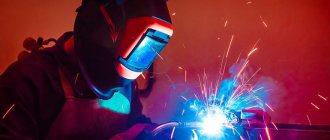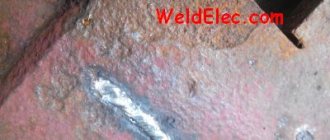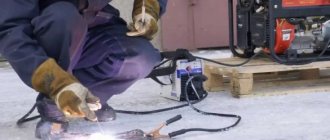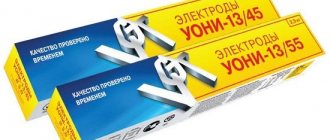How to set the welding current for a novice welder to weld metal from 1 to 5 mm
Welding current is one of the main parameters of electric arc welding. If this parameter is selected incorrectly, then it will not be possible to weld the metal efficiently.
Many errors during welding occur precisely due to incorrectly selected current values. For example, the electrode sticks or metal spatters, welding burns through the workpiece, etc. All this is due to incorrect welding current parameters.
It is difficult for a novice electric welder to decide and select the welding current. This is due to the fact that the welding current depends on many features, including the network voltage. How to set the welding current for a novice welder, read this article.
Preparing, purchasing, stocking up
The most important thing is to know that everything will work out perfectly, because inverter welding technology is very easy to learn and use; experience and skill are not particularly needed here.
Safety precautions
Any welding activity, including an inverter, is directly related to electrical current.
This means that without knowing and following safety rules on how to weld with a welding inverter, you should not start; this is not even discussed.
These rules are simple and straightforward:
- It is necessary to check the cables for integrity and serviceability before connecting to the inverter. It is important to remember: the return cable with a clothespin goes to the negative pole. We attach the cable, where there is an electrical holder, to the positive connector.
- After a visual check, set the current control knob to the minimum value. Then we connect the device to the network. We listen to the operation of the fan when it turns on: if the noise is smooth and without crackling, everything is in order.
- Now let's take into account the considerable weight of the metal with which you will have to work.
Workwear
Welding with an inverter.
First of all, you need to take into account the effect of high temperature and have the following items:
- welder's mask with special light filters;
- protective gloves or gaiter;
- suit made of protective fabric;
- shoes with rubber soles;
- if necessary, a respirator if welding takes place in a closed room without ventilation.
Equipment
List of required equipment:
- inverter welding machine;
- hammer;
- electrodes selected for the type of work, taking into account the nature and thickness of the metal;
- metal bristle brush
Classification by type of coating
There are 4 options:
Basic or calcium fluoride
Identified by the letter "B". It consists of calcium and magnesium carbonates. It may contain marble, magnesite, dolomite. These elements have a low oxidizing ability, due to which the process of removing oxygen from the molten metal is faster. The second name appeared due to the fact that the slag diluent is natural calcium fluoride - fluorite. The advantage of calcium fluoride electrodes is their low hydrogen content. This factor allows you to obtain a strong seam, without gases and impurities, and also minimize the risk of hot cracks. Consumables with a main protective layer are ideal for pipelines carrying hydrogen sulfide compounds, as they resist cracking well. But there is also a nuance. Everything must take place with a direct current of reverse polarity, since calcium fluoride inhibits the operation of components with alternating voltage and the welding arc may burn unstably. Choose electrodes with this type of coating if you plan to work with steel with a high sulfur content or a material that must withstand heavy loads or will be regularly exposed to high temperatures. They are also suitable for welding rigid structures.
Rutile
Despite the fact that a different type is called “main”, this is the option used in 95% of works. The gas released during combustion is non-toxic, so this is the safest solution for the health of the master. The metal seam made with the concentrate is resistant to cracks, does not bend or break, since the consumable material increases viscosity. This coating is ideal if the welder works with a short seam, because the arc burns well even if the voltage in the network fluctuates. For people who have not yet developed their hand and cannot hold it throughout the entire work process, this is the best option. In addition, you can operate with it in any spatial plane.
Sour
Suitable if welding work needs to be accelerated by forcing or lengthening the arc discharge. This is the most toxic type. Due to the increased level of splashing, it can only be interacted with in the lower position. It should not be used for high-temperature calcination. Not recommended for beginners.
With cellulose coating
Half consists of organic compounds - flour, starch, cellulose, half of natural and synthetic silicates. These are very thin consumables, so they can be used in any plane. With their help, a seam is created very easily, which increases the speed of completing the task several times, but the surface of the seam is uneven and requires grinding. Choose cellulose coating if you have to work with carbon and low-alloy steels. It is also suitable for hard-to-reach structures, since the diameter of such elements is minimal.
| type (designation in marking) | stamps |
| main (b) | uoni-13/45, uoni-13/45a, uoni-13/45, uoni-13/45a, uoni-13/45r, tmu-46, uoni-13/55, uoni-13/55k, uoni-13/ 55s, uoni-13/55u, uoni-13/55r, uoni-13/65, ozs-22r, 55-u, fno-t, fno-tm, fno-tm/n, its-4, its-4s, OZS-18, etc. |
| sour(s) | omm-5, cm-5, mez-4, etc. |
| rutile (r) | ano-21, ano-21m, ano-36, ozs-4, ozs-12, ozs-30, ozs-32, etc. |
| cellulose (c) | vsts-4, vsts-4m, oma-2, vsts-4a, etc. |
| mixed: carbonate-rutile (rb) | ozs-28, ano-3, ano-4, etc. |
| rutile-carbonate-fluoride | ozl-9a, etc. |
| ilmenite | ozs-41, mr-3u, mr-3r, etc. |
| rutile-cellulose (rc) | ano-13, fno-29m, etc. |
| acid-rutile (ar) | ano-6, ano-6m, ano-17, ozs-23, ano-24, etc. |
| rutile-ilmenite | mr-3m, etc. |
| with iron powder (g): rutile with powder filler (rzh) | ozs-6, ano-1, ano-27, uoni-13/55tzh, etc. |
| other (n) | for cast iron, non-ferrous alloys, salt. |
Let's start cooking
First we set the correct current strength on the inverter. We remember that in inverter technologies, alternating current welding is the main type. The strength of the welding current depends on the composition of the electrode and the diameter of its tip, the position of the workpieces during welding and the type of seam in the planned joint.
All these dependencies can be found in the comprehensive instructions for the device itself and in the inserts in packs of electrodes. Theoretically, the welding current can be selected according to the diameter of the electrode rod: for each millimeter of diameter there should be about 30 A.
We find a comfortable and stable position, put on a mask and begin work with the elbow abducted. It is better to wrap the forearm with a cable. If this is not done, your hand may get tired during welding, and the cable will begin to dangle, which will negatively affect the quality of the weld.
Direction of electrode movement for a novice welder.
For debut work, it is better to choose metal blanks that are not the smallest size - more than 20 cm, this will be more convenient. As beginners usually do: put on a mask, ignite an electric arc and immediately, with one breath, pass the workpiece along the entire length of the seam.
If your part is short and you weld it in one breath, you may develop the unnecessary habit of welding the seam in one breath. Therefore, train on long parts with proper breathing.
Now about the arrangement of objects during work. It is better to place the workpieces on a work table - a horizontal surface. The electrode in the holder should be at right angles to the table plane, then the angle of inclination should be approximately 30°.
Now you need to ignite the arc to move along the planned weld.
Welding can be done at a backward angle, in which case a 30° tilt goes in the direction of the seam. If the angle is forward, the electrode tilts in the opposite direction from the seam. The electrode should be held approximately like a pencil - at a height of 2 mm from the surface of the workpiece.
It must be remembered that when burning, the electrode shortens, so the distance above the surface must be constantly monitored.
How welding current for electrodes affects welding
When carrying out the welding process, it is necessary to select the correct current value. It is this parameter that largely influences the quality of the weld.
Low welding current
can lead to unstable arc combustion, the appearance of unwelded areas, the welding process will be constantly interrupted and, as a result, the welder will receive a poor-quality connection.
A value that is too high will result in overheating or burnout in the welding zone, as well as intense spattering.
In general, the choice of voltage indicators is influenced by several factors :
- brand and diameter of welding materials;
- spatial position of the rod during welding;
- voltage polarity (see the peculiarities of constant and alternating welding);
- seam size ;
- method ;
- type and thickness of metals being welded.
Now about the arc and electrodes
Quickly igniting and holding the arc correctly is perhaps the most important thing for successful welding with an inverter. The arc should not be interrupted - this is what you need to watch out for when the electrode approaches the workpiece plane.
The electrode is ignited in two ways: by tapping or striking. If the electrode is new, it ignites easily. If it has already burned, it is covered with a film of slag, which prevents the consumable from quickly igniting.
In this case, you should tap the electrodes longer so that the film breaks. The relationship between welding current and electrode diameter can be easily calculated using tables that are available in large numbers on the Internet.
Functional diagram of welding with an inverter.
If you have an advanced inverter model, then it is equipped with additional functions that make life easier for beginners and everyone else.
These advanced features are:
- The Hot Start or HotStart function makes it easier to ignite the electric arc.
- Anti-sticking or arc forcing is activated when the electrode approaches the metal surface too quickly. This function increases the current level.
- Antistick or AntiStick, on the contrary, turns off the current to prevent overheating of the welding machine.
It is better to learn from the simplest form of seam - a thread seam, for which the electrode must be guided evenly without any oscillatory movements.
Once you start to feel comfortable with the thread technology, you can start welding metals with oscillating movements in different configurations - there are several of them.
In such cases, you need to make the first few oscillatory movements to form a weld pool. We tilt the electrode at an angle of 30°, no more and no less. Once the pass is completed, you need to beat off the slag crust with a hammer to clean the new seam using a wire brush.
In order for the seam to come out high-quality and aesthetically pleasing, at the end you should make a couple of oscillatory movements towards the metal surfacing. In this way, crater formation can be avoided.
Technology for welding thin metal with an inverter for beginners
To achieve a decent result while maintaining occupational safety, you must adhere to a few simple rules:
- Clean the joints from dirt and possible rust (even if you see that there is no corrosion, just in case).
- Securely secure the workpieces so that they do not move out during the process.
- Preliminarily outline the connection line, so as not to get lost later and not to disturb the desired geometry - with dots every 5–7 cm.
- Complete the work as quickly as possible - without delays in any areas, in one pass.
- Set the minimum current strength - if the device has a smooth adjustment function, this will not be difficult.
- Monitor the open circuit voltage - it is important that it remains at least 70 V.
About welding seams
The seams that are formed using inverter welding are as follows:
- single-pass, in which the thickness of the metal workpiece is replenished in one pass;
- multi-pass, in which one pass of electrodes is not enough. Used when welding thick edges.
The most famous and simple way to check the quality of a seam after welding is to tap it with a hammer. At the same time, the slag layer bounces off - provided that the seam is even and smooth. Also, the quality of the seam depends on the temperature: it must be correct.
If the seam is overheated, it may break; if the heating is insufficient, a very unpleasant thing will happen - lack of penetration.
What is the difference between DC and AC electrodes?
The differences between DC and AC electrodes can be briefly explained by two statements:
- Welding materials designed for alternating current are also successfully used for welding with direct current. Therefore, experts often call such electrodes universal. More about them below.
- While DC electrodes are generally not suitable for AC welding.
However, it should be remembered that materials of the second group guarantee a better connection . When performing important work, this fact comes to the fore.
Polarity forward and reverse: what is the difference
Polarity in welding on an inverter machine is an extremely important thing that you need to understand.
If the welding current is constant, then the movement of electrons is also constant. And in this situation, there is almost no splashing of drops and pieces of molten metal, as a result of which the seam comes out neat and of high quality.
At its core, polarity is the direction of electron flow, which depends on the order in which the cables are connected to two different connectors on the device. Inverters have the ability to select the type of polarity. The welding current can also be adjusted.
Reverse polarity
Types of polarity for welding.
This is the negative pole on the metal workpiece, and the positive pole on the electrode. The current thus moves from minus to plus, that is, from the metal to the electrode. With this method, the electrode gets quite hot. The method is good when welding thin metals as the risk of burn-through is reduced.
Straight polarity
Here it’s the other way around: the negative pole is on the electrode, and the positive pole is on the metal of the workpiece. The current now flows from the electrode to the part being welded, which in this case heats up more than the electrode. This is how they work with thick metal edges.
It should be noted that the polarity is always indicated in the instructions on the packs of electrodes.
One of the main “inverter” questions from debutants is what is the most optimal polarity when welding with an inverter? The answer depends on many criteria, but from the point of view of cutting metal, the polarity should be straight.
The fact is that with this type of polarity, the molten area turns out to be deep and narrow - just what is needed when cutting.
With reverse polarity, the opposite is true: the melting zone is shallow and quite wide.
The right technology: how to weld thin metal using electric welding
According to the recommendations, this problem needs to be solved in 3 stages:
- Take preliminary measures.
- Connect the parts.
- Clean the seams.
The selection of equipment is carried out mainly for the first two steps, which is why they deserve the closest attention and detailed consideration.
Preparatory work
They boil down to cleaning all contact surfaces of the joint from any possible types of contamination. Particular attention must be paid to the installation point of the supporting part of the apparatus.
Corrosion stains should be carefully removed with sandpaper. It is also better to remove the zinc coating (if any) using a grinder, although if time is pressing, you can leave it in the expectation that it will melt when heated. But it is still recommended to remove it so as not to create unnecessary irregularities.
Cook, cut
If you are working with thin sheets of metal, you need to choose the right small diameter electrode and welding current. If, for example, the edge thickness of your part is 0.8 mm, the diameter of the electrodes should be 1.8 mm. Well, the welding current should reach 35 A. You need to cook using intermittent movements.
The question of which electrodes to weld with is decided taking into account the type of welding and the nature of the metal.
Using an inverter, you can cut metals and even make holes in pipe walls. In order to do this competently and quickly, you need to set the correct parameters on the device. An electrode diameter of 2.5 mm and a current of 140 A are just such indicators.
We ignite the electrode and place it exactly at the location of the planned hole. Press for good heating. We rearrange the electrode, press and heat again. And so on until a hole of the desired shape and size is cut.
If you are cutting sheet metal, the sheet must be fixed vertically. In this case, drops of molten metal will flow down, otherwise you risk getting frozen metal icicles at the bottom of the cut.
To be honest, all cutting of metals with a welding machine, even with the most advanced inverter, is not the best idea from a technical point of view. There is always a risk of metal melting at the cut site - the metal can simply melt out. The best way to cut metal is with a grinder.
How to carry out the procedure with thin-walled objects
Let's assume that the thickness of the workpiece is 1-1.5 mm. It is quite difficult to select an electrode for it, because it must have an even smaller cross-section (according to unspoken rules). Is it really 0.7-0.9 mm? You won’t be able to find such consumables on sale; they simply don’t exist; standard rulers start at 2–3 mm. Yes, one and a half ones are also available, you can buy them, but they are also uncomfortable for beginners to work with.
To solve the problem, you need to use special equipment that generates direct current under high voltage. It is easy to adjust, and with its help it is quite possible to ensure excellent seam quality.
We choose, we buy
Table of characteristics for welding with an inverter.
It would be useful to google and read about domestic and foreign manufacturers whose products are offered on the Russian market. These are mainly European and Asian countries.
Equipment from Asia is usually inexpensive and of very decent quality, with the exception, of course, of handicraft fakes.
European inverters are distinguished by qualities with the obligatory adjective “high” in front: high price, high reliability, high quality. There are few Russian devices on the market.
Understand the brand of welding cable and its cross-sectional area. The right choice will help you avoid difficulties with power surges if they occur during welding.
The second thing to do is figure out the availability of service centers around the country. If you live in a city with a population of one million, a service center for a specific product is unlikely to be a problem for you. But if you live in a remote region, this issue will become one of the most important for you.
To be honest, you won’t be able to buy one device. Be sure to buy a welding helmet with a light filter. You need to protect yourself from splashes of molten metal and combustion products.
But the main thing is protection from ultraviolet radiation from a hot arc. The most primitive option is a mask made of plastic and a light filter, which is selected depending on the current strength, lighting and your vision.
A more expensive and much more comfortable option is a mask with a Chameleon-type light filter, which automatically changes its characteristics and can be adjusted to suit the ambient light and the condition of your eyes.
There are many tables on the Internet with data that will help you choose the right filters. It is better to choose them for a number larger or smaller. The best solution would be to check the lighting in the work area and your vision.
Okay, we agree, you don’t have to buy a whole suit made of special fabric. But a canvas apron with gloves is not a whim, but your protection. It is better to choose mittens from split leather. Pay attention to your shoes: be aware that drops of molten metal may fall on your feet.
Let's sum it up
This matter has its own specifics, there are many methods, and each of them, with its own characteristics, you just need to remember. In the process of performing a technological operation, it is important to avoid haste or delay. But the result is impressive - an aesthetically pleasing object that does not leak, without cracks or chips.
Now that you know how to weld thin metal using electric welding, you can immediately purchase consumables and start working. will help you with this - we sell bandsaw machines, to clarify the information you are interested in, contact our managers at the contact numbers listed on the page. Select conductors, set the mode, start solving the problem, armed with knowledge about this equipment. Contact Rosta LLC if you decide to buy devices for industrial use. We have manual and semi-automatic band saws in stock and on order, as well as pendulum, vertical and two-post units. To contact our specialists, call the contact numbers listed on the page.
How to care for the inverter?
Any equipment loves care and order, your inverter is by no means an exception. The rules on how to properly cook using inverter welding and how to store it correctly are simple.
Selecting an electrode for welding various metals.
Before work you need to do the following:
- carry out a visual inspection of the device and prepare the place where you are going to work;
- install the inverter in a horizontal position with the desired protection from dust, precipitation and other contaminants;
- connect the cable to the connectors in accordance with your plans, usually this is plus to the electrode and minus to the metal;
- connect power supply. The most important nuance: if you use an extension cord, the cross-section of the welding cable must be at least 2.5 mm².
- ignite the arc at separation as a test test;
- make sure the casing is intact, because cooking without it is strictly prohibited;
- adjust the current mode. You can start cooking.
You must store your device according to the following rules:
- Constantly check all components of the device. The frequency of checks depends on the intensity of use of the device and the degree of dust in the work area;
- Clean the device from dust using compressed air and low pressure. Do not clean the electric plateau with a jet of air, but use a soft brush;
- check the strength of power connectors, the integrity of the plug, socket and insulating coating of electrical cables;
- It is better to store the inverter in dry conditions, the air temperature should be within the range from -15°C to +50°C, the optimal air humidity is about 70 - 80%.
- Remember to disconnect the inverter from the network when it is not working.
Do-it-yourself welding of thin metal with an inverter
It is necessary to adhere to the following algorithm:
- Clear the end of the electrode (approximately 5 mm) from the coating - for the fastest possible ignition.
- Make a short-term fire and pinpoint the material along the entire seam line, at intervals of 5–7 cm - this will help prevent possible deformation.
- To ignite an arc for continuous use, simply strike the filler rod against the metal or tap it. Maintain a flame length of 2–3 mm and a distance corresponding to the cross-section of the consumable (see table).
- Make a bath of melt, trying to keep it an elongated oval shape, and start making a seam - then it will most likely turn out to be of high quality.
- Carry out the passage smoothly and quickly, without bringing the conductor closer to the part to avoid drops.
When discussing how to weld thin metal (iron) with an inverter for beginners, we always advise using a machine with arc forcing and anti-stick functions. It is more convenient than usual, because it regulates the process and automatically adds tension when the flame stretches excessively or releases it when the filler rod gets dangerously close to the workpiece.
In addition, to ensure a high-quality result, you should adhere to the following rules:
- Position the holder so that it is at a 60-degree angle to the surface and does not block the view of the seam and the bath. If you tilt it too much, the joint will be bulging and uneven.
- Monitor the speed of movement, trying to maintain a uniform and progressive motion.
- Move the electrode from bottom to top (for vertical joints) or from left to right (for horizontal joints); the trajectory should be zigzag.
Knowing how to properly weld thin metal using inverter welding, do not forget that after the operation is completed, the joint should be carefully inspected: clean off the slag and make sure there are no burns or lack of penetration.
Converter operation
This is a device with reverse polarity, that is, it is connected to the workpiece with a minus, and to the conductor with a plus. This eliminates the very possibility of defects occurring. The rod heats up stronger and faster than the material at the point of contact, especially if this consumable is of good quality (from a foreign company, with known properties, proven in practice). It is also important that it has high buoyancy and its diameter does not exceed 2 mm.
There are many videos showing how to perform passes. Check out some of them and you'll avoid making common mistakes.
Advantages of thin-walled blanks
Welded strictly according to technology, using modern equipment, with neat seams, they:
- They have an aesthetic and even attractive appearance, because there is no scale on their surfaces.
- Exactly correspond to the design dimensions, not deformed, since during their production the material was not subject to temperature changes.
- They are completely ready for painting or other coatings because there is no slag on them.
- They can boast of a strictly planned shape, without holes, depressions or tubercles, if the stress during their manufacture was constant.
The parts have all the described advantages because they are manufactured using advanced equipment, the only drawback of which is possible interruptions when working in conditions of very sub-zero temperatures. But this is, in principle, typical for any technology of this kind.
Which electrodes are best for cooking: choose by type of metal products
Fence
Consumables with rutile coating are a win-win for a beginner. This is AHO with numbers 4,6, 21, 36., MP-3, OK-4600. You can also take rods of mixed recipes “Monolith”, “Granite”, “Arsenal”. The advantage is easy initiation of the electric arc. You will be able to weld with a tear, and pores will not form in the seam. Effective when you need to quickly erect a multi-meter structure.
Thin metal
To avoid burning holes, look for elements with a minimum diameter: we have already discussed how to choose the right electrode for welding above - correlate it with the thickness of the sheet.
Pipes
Gas is treated with grades OK-46 and LB-52. For the heating system, purchase E42A, UONI-13/45, for water supply - MN-5 and MNZh5.
Channel
It all depends on the size of the part. If they are small, then he chooses five or six millimeter ANO-21. You can even cook rusty surfaces with them. If the dimensions of the channel are impressive, only UONI-13/55U. They do not limit the master: alternating and direct current, reverse and direct polarity.
Rails
Experts recommend brands UONI-13/45 and UONI-13/55.
